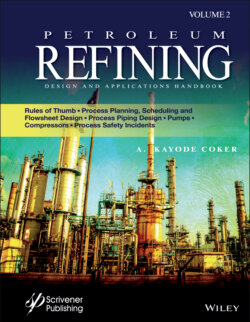Читать книгу Petroleum Refining Design and Applications Handbook - A. Kayode Coker - Страница 57
14.7 General Arrangements Guide
ОглавлениеEach phase of the process is best represented on individual flowsheets. Electric power, fuel gas, drainage and the many other auxiliary system requirements are also best defined by separate individual flowsheets. These should be complete including all headers, branch take-offs, tie-ins to existing or known points, and so on. Only in this way can all the decisions as well as specifications be delineated for the various parts contributing to the entire project. The master process or mechanical flowsheet must contain specific references to the other sheets for continuation of the details and complete coordination.
Flowsheet size may vary depending upon the references of the individuals using them. The most popular system uses one size sheet about 24 × 36 inches for all flowsheets. The use of miscellaneous large and small sizes to represent the entire project is often awkward when collected, and increases the possibilities of sheets becoming misplaced. Some groups use sheets from a roll and these are sized to length by systems, becoming 24 × 60 inches, and 24 × 72 inches or longer. These are fine for initial study but become tedious to handle on the usual desk. These sheets can be reduced to 11 × 36 inches or 11 × 48 inches both of which are more convenient to work with. These strip-type sheets allow large portions of the process to be grouped together, and are adaptable for folding into reports, and so on.
Figure 14.13 Typical process area plot plan and study elevations [9].
Figure 14.14 Flowsheet scale reference diagram [11].
Since the flowsheet is the primary reference for all engineers working on a project, it must contain all of the decisions, data, flow connections, vents, drains, and so on, which can reasonably be included without becoming confusing and difficult to read.
It is important that the various items of equipment and valves be spaced, pictorially represented and sized as to be easy to read, recognized, and followed. On the surface this may sound easy, while in reality it takes an experienced flowsheet detailer to arrange the various items in an eye pleasing and efficient arrangement. Suggestive outline figures plus shading often yield the best looking flowsheet; however, the extra time for detail costs time and money. Some compromise is often indicated. Reference to the various flowsheets illustrated here indicates that the equipment can be arranged by (1) working from a base line and keeping all heights relative and (2) by placing the various items in a straight-through flow pattern without relative heights. The first scheme is usually preferred for working flowsheets. Whenever possible, all auxiliary as well as spare equipment is shown. This facilitates the full and proper interpretation of all the details.
Figure 14.14 [11] can be used as a guide in establishing relative sizes of equipment as represented on a flowsheet. This chart is based on approximate relative proportions pictured by the mind’s eye [11]. For example, the 10-foot diameter × 33-foot high tank would scale to 1.5 in. high. By using the height-developed scale factor, the diameter would be (1.5″/33′) (10′) = 0.45″ or say 0.5″ diameter on the flowsheet.
For some purposes the addition of equipment specification and performance data on the flowsheets adjacent to the item is of value. In many cases though, this additional information makes the sheets difficult to read. The use of equipment summary tables similar to flow and pipe data tables can avoid this objection and yet keep the information on the sheets. Some flowsheets include relief valve set pressures adjacent to the valves, volume capacities of storage tanks, and so on.
